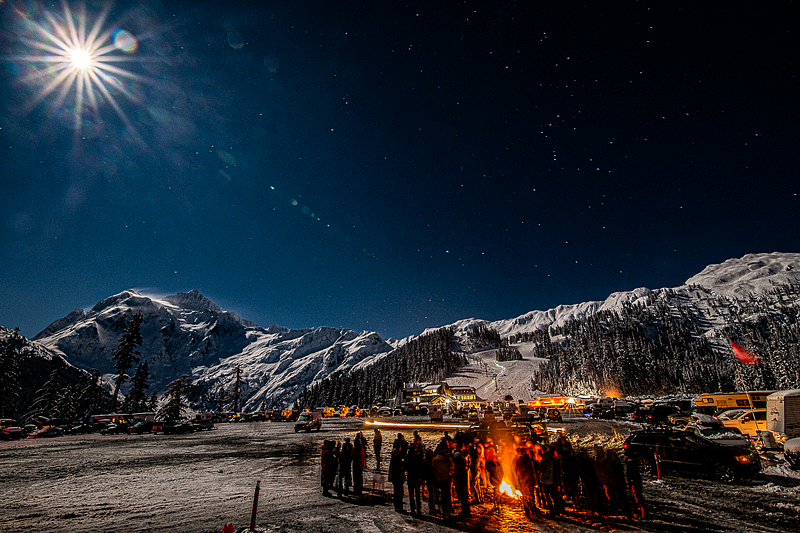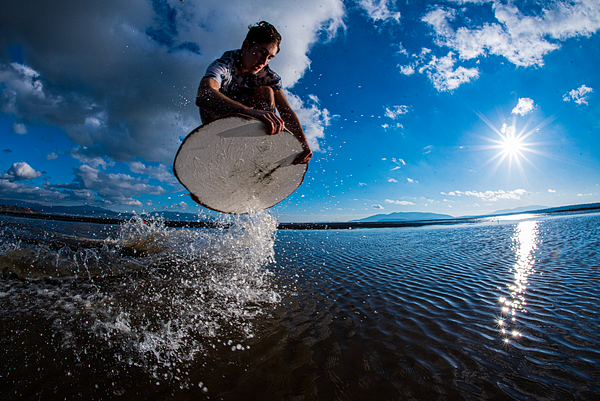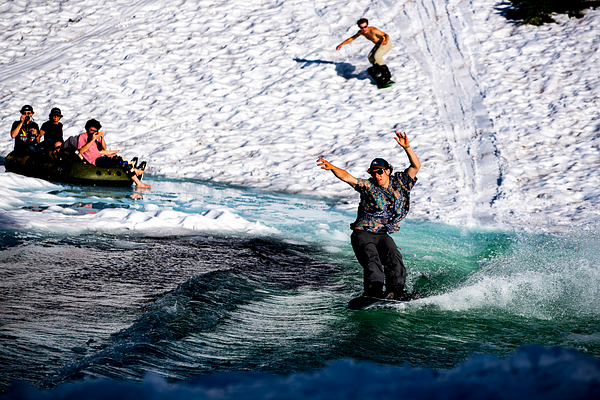Life in the Viewfinder

lot with Mt. Shuksan and the ski area in the background during the weekend of the Legendary
Banked Slalom on Feb. 8, 2020. Photo by Alex Moreno
The powerful effects of capturing moments.
Story and Photos by Alex Moreno
Nobody would have anticipated the 14-year-old with an out-of-focus and poorly exposed roll of film featuring subjects of grass, garbage and trees to eventually live a life revolving around cameras.
I was a rebellious punk with off-the-wall energy. The only time I would chill out was while contemplating how the shutter release would filter light to expose a frame of film in a way my eyes couldn’t. I was fascinated and hooked, despite my poor results.
I’d often shoot a roll over a few weeks. I meticulously planned the composition, the sensitivity of certain films to light, the focus and everything else I could muster together to create a decent photo. My attention to detail contrasted the smartphone assisted snap-craze of shooting countless pictures with little thought, then later finding a picture to put a filter on.

National Park on Sep. 7, 2013. Photo by Alex Moreno
Cameras on smartphones have revolutionized accessibility for people who would never invest in a dedicated camera. Smartphone cameras remove the variable manual controls that a user needs to learn about a camera. It robs the user of the thought process behind capturing a moment.
More pictures are being taken now than ever in history, thanks to smartphones. In 2017, it was estimated that 1.2 trillion digital photos were taken and 85% of the photos were captured on a smartphone.
It’s no surprise the number of pictures being taken has skyrocketed since social media presence has become an important part of our culture. From stories of fancy dishes and daily activities to posts of parties and travel, photos posted to social media have become a way for people to showcase their best moments.
People’s demeanor changes quickly when the camera comes out. Think about the shift that being in front of a camera causes the next time a phone comes out for a picture with close friends, family or even strangers. Often the result is subjects shaping themselves into unnatural positions while forcing smiles and emotions for the camera, not a genuine or found moment. The effects of the “do it for the ‘gram” mentality are undeniable and widespread.

I’ve always wanted to both live in the moment and take a picture. It is a delicate balancing act between only experiencing something through a representation of the moment on a screen and enjoying the moment itself.
A camera provides the ability to capture the world in the way the user wishes to depict it. The impact often changes the viewer’s experience with the world around them but shouldn’t take the place of fully experiencing moments.
Some psychologists believe that when someone takes a picture they are less likely to remember details of what they’re photographing, which is referred to as the “photo-taking-impairment effect.”
Linda Henkel, a psychologist at Fairfield University in Connecticut, studied this effect using art exhibits. Subjects looked at a piece for 20 seconds, then took a picture of the whole piece, zoomed in on a part of it or did not take a picture of the piece at all.
“If participants took a photo of each object as a whole, they remembered fewer objects and remembered fewer details about the objects and the objects’ locations in the museum than if they instead only observed the objects and did not photograph them,” Henkel wrote.
Despite the loss of memory for people picturing objects in their entirety, the study showed that participants who zoomed in on specific features retained the same level of memory for the whole object when compared to those who did not picture the object. Photography isn’t detrimental toward any experience or memory unless you operate as a passenger on the journey.
I’ve always wanted to both live in the moment and take a picture.
After being stuck in the viewfinder for long enough, I’ve let the analytical approach seep into all aspects of my life. I often catch myself thinking what a sun-star would look like with the light breaking through a specific layer of clouds or look for compositions without a camera in hand.
Photography has shifted my life drastically for the better. In high school, I received honorable mentions in state photography competitions. I was always far from first place, but I was thrilled and motivated to be even slightly recognized while struggling in all my other academic endeavors. Despite the motivation, after high school I let my camera collect dust, only brushing it off when I had a spark of inspiration. Most of my time was tied up in the unremarkable pursuit of a business degree.


the Bellingham Bay on Oct. 12, 2018. Right: Stephen Baddeley rides across a pond
skim followed by Ben Bartlett in the Mt. Baker Ski Area on June 11, 2019. Photos by Alex Moreno
After almost two years of making steps toward a business degree, I realized what I always knew: I’m terrible at math and much prefer playing with my camera.
Although math didn’t disappear — camera gear doesn’t come cheap, so it’s too often a numbers game of rationing living expenses toward used gear sales. With goals of becoming a working professional after graduating in spring 2020, hopefully the rations will finally bring home the bacon. But the odds aren’t exactly in my favor.
After almost two years of making steps toward a business degree, I realized what I always knew: I’m terrible at math and much prefer playing with my camera.
In 2018 the U.S. Bureau of Labor Statistics estimated there were 49,560 non-self-employed professional photographers in the U.S.
The release of the first phone with a camera in 2000 slowly grew to change the photography landscape. Digital camera sales were still on the rise with a peak of 121 million units sold in 2010, but in 2018 there were only 19.4 million units shipped out. If everyone has a capable camera in their pocket, then only the dedicated hobbyists or professionals are left to buy actual cameras. And if everyone can take a decent picture, why hire a photographer?
Despite their differences, professionals and amateurs are both drawn in deeper to an experience by taking in a whole scene and focusing on how to best convey it, but only if the thought-process behind a photo is part of the experience.

start shack of the Legendary Banked Slalom with Mt. Shuksan in the background on Feb. 8,
2020. Photo by Alex Moreno
“It may be that our photos can help us remember only if we actually access and interact with them, rather than just amass them,” Henkel wrote.
While everyone is a photographer in some aspect, it’s easy to lose sight of why we want to take photos in the first place. We are living in a digital world — a time of revolution in photography and its impact on society.
Cameras will never replace our memories, but they can change them, and it’s the user who decides for what reasons, in what ways and if for better or worse.
As for me, I’m always looking forward to snapping my next frame so I can look back and build upon it. The subjects in the viewfinder have changed over the years from discarded popcorn bags in the grass to landscapes and action sports, but my passion remains constant.
